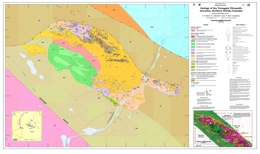| Publication Summary
|
| Issue ID: | OF2012-05 |
| Title: | Geology of the Turnagain Ultramafic Intrusion, Northern British Columbia (parts of NTS 104I/07 and 10) |
| Author(s): | Nixon, G.T., Hitchins, A.C., Ross, G.P. |
| Series Name: | Open File |
| Publication Year: | 2012 |
| NTS Map Sheet(s): | 104I/07,10 |
| Place Keyword(s): | British Columbia, Northwest, Cry Lake, Dease Lake, Turnagain Lake |
| Lat/Long (NSWE): | 58.51, 58.45, -128.95, -128.79 |
| Theme Keyword(s): | Geology, bedrock map, geophysical map, Magmatic Ni-Cu-PGE sulphide deposits, Turnagain ultramafic intrusion |
| Download(s): | |
Abstract:  | Magmatic Ni-Cu-PGE sulphide deposits in supra-subduction zone (SSZ) settings are becoming an increasingly important economic resource worldwide yet remain poorly understood and underexplored. Projects initiated recently under the Targeted Geoscience Initiative No 4 in the Canadian Cordillera seek to address critical knowledge gaps in order to develop new mineral deposit models and robust exploration criteria. The Turnagain ultramafic intrusion is an Early Jurassic Alaskan-type body emplaced in a SSZ setting and unusually enriched in Ni-Cu-PGE sulphides. The new geology map incorporates previous BCGS mapping supplemented by geological, geophysical and ongoing exploration work (drillhole and trenching information) supplied by Hard Creek Nickel Corporation (HNC). The main mineralization is hosted by wehrlite and dunite (Horsetrail zone), and the principal sulphide minerals are pyrrhotite, pentlandite and chalcopyrite. Regional geophysical surveys conducted by HNC indicate that the highly conductive graphitic metasedimentary wallrocks (Mississippian in part) of the Turnagain intrusion are separated from miogeoclinal strata of Ancestral North American by a steeply dipping reverse fault, and represent the basement to the accreted Quesnel Terrane (Yukon-Tanana Terrane). This interpretation appears consistent with the tight to slightly overturned, eastward-verging folds in the graphitic phyllites documented by Erdmer et al. (2005) and juxtaposed strata of the Ancestral North American miogeocline which occupy the southwesterly-dipping limb of a large homoclinal structure (Gabrielse, 1998). |





